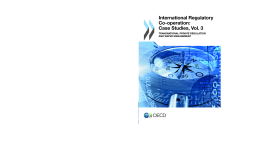
BOOK
International Regulatory Co-operation
(2013)
Additional Information
Book Details
Abstract
The world is becoming increasingly global. This raises important challenges for regulatory processes which still largely emanate from domestic jurisdictions. In order to eliminate unnecessary regulatory divergences and to address the global challenges pertaining to systemic risks, the environment, and human health and safety, governments increasingly seek to better articulate regulations across borders and to ensure greater enforcement of rules. But, surprisingly, the gains that can be achieved through greater co-ordination of rules and their application across jurisdictions remain largely under-analysed.
This volume complements the stocktaking report on International Regulatory Co-operation: Rules for a Global World by providing evidence on regulatory co-operation in the area of transboundary water management and through the fast development of transnational private regulation.
Table of Contents
| Section Title | Page | Action | Price |
|---|---|---|---|
| Cover\r | Cover | ||
| Content\r | vi | ||
| Abbreviations and acronyms | viii | ||
| Chapter 1:\rTransnational private regulation | 1 | ||
| The context of transnational private regulation | 2 | ||
| Main characteristics of transnational private regulation | 2 | ||
| Why is TPR taking place? | 2 | ||
| Who are the transnational private regulators? | 4 | ||
| What is subject to regulation? | 6 | ||
| How do these organisations regulate? | 7 | ||
| Where does regulation occur? | 7 | ||
| Evolution of regulatory chains: The birth of meta-regulators | 8 | ||
| An overview of transnational regulatory co-operation | 9 | ||
| A typology of the actors involved | 10 | ||
| How do TPR schemes frame and implement co-operation? | 13 | ||
| Levels of co-operation | 13 | ||
| Formality | 14 | ||
| Instruments used for co-operation | 15 | ||
| Functional dimension of co-operation | 16 | ||
| Preliminary stage | 16 | ||
| Co-operation within the regulatory process | 16 | ||
| Activities surrounding the regulatory process: Recognition ofstandards – benchmarking | 17 | ||
| Why are co-operative TPR schemes created? | 17 | ||
| Reasons for first tier co-operation | 18 | ||
| Efficiency, inter-firm co-ordination and competition, collusion | 18 | ||
| Complementing or pre-empting public regulation | 18 | ||
| Enhancing legitimacy and effectiveness | 19 | ||
| Controlling the value chain | 19 | ||
| Overcoming missing competencies | 20 | ||
| Reasons for second tier co-operation | 20 | ||
| Proliferation and fragmentation | 20 | ||
| Conflict avoidance and creation of coherency | 21 | ||
| Reducing transaction costs through standardisation | 22 | ||
| Enhancing quality and effectiveness | 23 | ||
| Improving effectiveness of compliance mechanisms | 23 | ||
| Signalling and enhancing legitimacy | 24 | ||
| Broadening the scope of regulatory activities | 24 | ||
| Achieving competitive advantage | 24 | ||
| Assessment | 25 | ||
| Conclusion | 30 | ||
| Notes | 32 | ||
| Bibliography | 42 | ||
| Chapter 2:\rTransboundary water management | 51 | ||
| Introduction | 52 | ||
| An overview of mechanisms and actors | 53 | ||
| Legal principles and agreements | 53 | ||
| Institutional arrangements in support of IRC | 58 | ||
| Main co-operation mechanisms used | 59 | ||
| Instruments of co-ordination | 59 | ||
| Functions being co-ordinated/components covered in agreements | 60 | ||
| Overall assessment and next steps | 61 | ||
| Known benefits | 61 | ||
| Challenges | 62 | ||
| Requirements of successful co-ordination | 64 | ||
| Costs | 67 | ||
| Next steps | 67 | ||
| A case in point: The International Commission for the Protection of the Rhine | 68 | ||
| Main characteristics | 68 | ||
| Actors involved | 68 | ||
| Intended objectives | 69 | ||
| Form that the co-operation is taking | 70 | ||
| Short history of the development of the ICPR | 70 | ||
| Assessment | 73 | ||
| Known benefits15 | 73 | ||
| Challenges (and when they exist, mechanisms to overcome them) | 73 | ||
| Costs | 74 | ||
| Next steps | 74 | ||
| Notes | 75 | ||
| Annex 2.A1:\rInternational legal and soft law instruments affecting transboundary water governance | 78 | ||
| Annex 2.A2:\rExamples of international agreements for the transboundary management of individual water courses | 82 | ||
| Annex 2.A3:\rUnited Nations engagement | 86 | ||
| Annex 2.A4:\rNon-governmental organisations and initiatives on transboundary water | 88 | ||
| Annex 2.A5:\rDevelopment of co-ordination with respect to the Rhine: Main landmarks | 90 | ||
| Bibliography | 91 | ||
| ORGANISATION FOR ECONOMIC CO-OPERATIONAND DEVELOPMENT | 95 |
